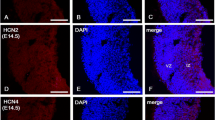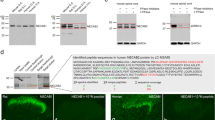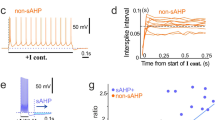Abstract
The expression pattern and functional roles for calcium-activated potassium channels of the KCa2.x family and KCa1.1 have been extensively examined in central neurons. Recent work indicates that intermediate conductance calcium-activated potassium channels (KCa3.1) are also expressed in central neurons of the cerebellum and spinal cord. The current study used immunocytochemistry and GFP linked to KCNN4 promoter activity in a transgenic mouse to determine the expression pattern of KCa3.1 channels in rat or mouse neocortex, hippocampus, thalamus, and cerebellum. KCa3.1 immunolabel and GFP expression were closely matched and detected in both excitatory and inhibitory cells of all regions examined. KCa3.1 immunolabel was localized primarily to the somatic region of excitatory cells in cortical structures but at the soma and over longer segments of dendrites of cells in deep cerebellar nuclei. More extensive labeling was apparent for inhibitory cells at the somatic and dendritic level with no detectable label associated with axon tracts or regions of intense synaptic innervation. The data indicate that KCa3.1 channels are expressed in the CNS with a differential pattern of distribution between cells, suggesting important functional roles for these calcium-activated potassium channels in regulating the excitability of central neurons.









Similar content being viewed by others
References
Adelman JP, Maylie J, Sah P (2012) Small-conductance Ca2+−activated K+ channels: form and function. Annu Rev Physiol 74:245–269. doi:10.1146/annurev-physiol-020911-153336
Akakin D, Sirvanci S, Gurbanova A, Aker R, Onat F, San T (2011) Ultrastructural GABA immunocytochemistry in the mossy fiber terminals of Wistar and genetic absence epileptic rats receiving amygdaloid kindling stimulations. Brain Res 1377:101–108. doi:10.1016/j.brainres.2010.12.066
Allen D et al (2011) The SK2-long isoform directs synaptic localization and function of SK2-containing channels. Nat Neurosci 14:744–749. doi:10.1038/nn.2832
Andrade R, Foehring RC, Tzingounis AV (2012) The calcium-activated slow AHP: cutting through the Gordian knot. Front Cell Neurosci 6:47. doi:10.3389/fncel.2012.00047
Ballesteros-Merino C et al (2012) Developmental profile of SK2 channel expression and function in CA1 neurons. Hippocampus 22:1467–1480. doi:10.1002/hipo.20986
Barmeyer C, Rahner C, Yang Y, Sigworth FJ, Binder HJ, Rajendran VM (2010) Cloning and identification of tissue-specific expression of KCNN4 splice variants in rat colon. Am J Physiol Cell Physiol 299:C251–C263. doi:10.1152/ajpcell.00091.2009
Bednarczyk P (2009) Potassium channels in brain mitochondria. Acta Biochim Pol 56:385–392
Begenisich T et al (2004) Physiological roles of the intermediate conductance, Ca2+−activated potassium channel Kcnn4. J Biol Chem 279:47681–47687. doi:10.1074/jbc.M409627200
Belmeguenai A et al (2010) Intrinsic plasticity complements long-term potentiation in parallel fiber input gain control in cerebellar Purkinje cells. J Neurosci 30:13630–13643. doi:10.1523/JNEUROSCI.3226-10.2010
Benhassine N, Berger T (2005) Homogeneous distribution of large-conductance calcium-dependent potassium channels on soma and apical dendrite of rat neocortical layer 5 pyramidal neurons. Eur J Neurosci 21:914–926. doi:10.1111/j.1460-9568.2005.03934.x
Berkefeld H, Fakler B, Schulte U (2010) Ca2+−activated K+ channels: from protein complexes to function. Physiol Rev 90:1437–1459. doi:10.1152/physrev.00049.2009
Boettger MK et al (2002) Calcium-activated potassium channel SK1- and IK1-like immunoreactivity in injured human sensory neurones and its regulation by neurotrophic factors. Brain 125:252–263
Bond CT et al (2004) Small conductance Ca2+−activated K+ channel knock-out mice reveal the identity of calcium-dependent afterhyperpolarization currents. J Neurosci 24:5301–5306. doi:10.1523/JNEUROSCI.0182-04.2004
Bouhy D et al (2011) Inhibition of the Ca(2)(+)-dependent K(+) channel, KCNN4/KCa3.1, improves tissue protection and locomotor recovery after spinal cord injury. J Neurosci 31:16298–16308. doi:10.1523/JNEUROSCI.0047-11.2011
Chen YJ, Raman G, Bodendiek S, O’Donnell ME, Wulff H (2011) The KCa3.1 blocker TRAM-34 reduces infarction and neurological deficit in a rat model of ischemia/reperfusion stroke. J Cereb Blood Flow Metab 31:2363–2374. doi:10.1038/jcbfm.2011.101
De Marchi U et al (2009) Intermediate conductance Ca2+−activated potassium channel (KCa3.1) in the inner mitochondrial membrane of human colon cancer cells. Cell Calcium 45:509–516. doi:10.1016/j.ceca.2009.03.014
Engbers JDT et al (2012) Intermediate conductance calcium-activated potassium channels modulate summation of parallel fiber input in cerebellar Purkinje cells. Proc Natl Acad Sci U S A 109:2601–2606. doi:10.1073/pnas.1115024109
Ernst C, Christie BR (2006) Isolectin-IB 4 as a vascular stain for the study of adult neurogenesis. J Neurosci Methods 150:138–142. doi:10.1016/j.jneumeth.2005.06.018
Fanger CM et al (1999) Calmodulin mediates calcium-dependent activation of the intermediate conductance KCa channel, IKCa1. J Biol Chem 274:5746–5754
Franklin KBJ, Paxinos G (2008) The mouse brain in stereotaxic coordinates. Elsevier, Amsterdam
Furness JB et al (2003) Expression of intermediate conductance potassium channel immunoreactivity in neurons and epithelial cells of the rat gastrointestinal tract. Cell Tissue Res 314:179–189. doi:10.1007/s00441-003-0808-z
Furness JB et al (2004) Intermediate conductance potassium (IK) channels occur in human enteric neurons. Auton Neurosci 112:93–97. doi:10.1016/j.autneu.2004.02.003
Gardos G (1958) The function of calcium in the potassium permeability of human erythrocytes. Biochim Biophys Acta 30:653–654
Grossmann R, Stence N, Carr J, Fuller L, Waite M, Dailey ME (2002) Juxtavascular microglia migrate along brain microvessels following activation during early postnatal development. Glia 37:229–240. doi:10.1002/glia.10031
Gulledge AT, Dasari S, Onoue K, Stephens EK, Hasse JM, Avesar D (2013) A sodium-pump-mediated afterhyperpolarization in pyramidal neurons. J Neurosci 33:13025–13041. doi:10.1523/JNEUROSCI.0220-13.2013
Hu H, Vervaeke K, Storm JF (2007) M-channels (Kv7/KCNQ channels) that regulate synaptic integration, excitability, and spike pattern of CA1 pyramidal cells are located in the perisomatic region. J Neurosci 27:1853–1867. doi:10.1523/JNEUROSCI.4463-06.2007
Hu H et al (2001) Presynaptic Ca2+−activated K+ channels in glutamatergic hippocampal terminals and their role in spike repolarization and regulation of transmitter release. J Neurosci 21:9585–9597
Ishii TM, Silvia C, Hirschberg B, Bond CT, Adelman JP, Maylie J (1997) A human intermediate conductance calcium-activated potassium channel. Proc Natl Acad Sci U S A 94:11651–11656
Jensen BS, Strobaek D, Olesen SP, Christophersen P (2001) The Ca2+−activated K+ channel of intermediate conductance: a molecular target for novel treatments? Curr Drug Targets 2:401–422
Jensen BS et al (1998) Characterization of the cloned human intermediate-conductance Ca2+−activated K+ channel. Am J Physiol 275:C848–C856
Joiner WJ, Wang LY, Tang MD, Kaczmarek LK (1997) hSK4, a member of a novel subfamily of calcium-activated potassium channels. Proc Natl Acad Sci U S A 94:11013–11018
Kanazawa H, Ohsawa K, Sasaki Y, Kohsaka S, Imai Y (2002) Macrophage/microglia-specific protein Iba1 enhances membrane ruffling and Rac activation via phospholipase C-gamma-dependent pathway. J Biol Chem 277:20026–20032. doi:10.1074/jbc.M109218200
Kaushal V, Koeberle PD, Wang Y, Schlichter LC (2007) The Ca2+−activated K+ channel KCNN4/KCa3.1 contributes to microglia activation and nitric oxide-dependent neurodegeneration. J Neurosci 27:234–244. doi:10.1523/JNEUROSCI.3593-06.2007
Khanna R, Roy L, Zhu X, Schlichter LC (2001) K+ channels and the microglial respiratory burst. Am J Physiol Cell Physiol 280:C796–C806
Klocker N, Oliver D, Ruppersberg JP, Knaus HG, Fakler B (2001) Developmental expression of the small-conductance Ca(2+)-activated potassium channel SK2 in the rat retina. Mol Cell Neurosci 17:514–520. doi:10.1006/mcne.2000.0956
Lancaster B, Nicoll RA (1987) Properties of two calcium-activated hyperpolarizations in rat hippocampal neurones. J Physiol 389:187–203
Ledoux J et al (2008) Functional architecture of inositol 1,4,5-trisphosphate signaling in restricted spaces of myoendothelial projections. Proc Natl Acad Sci U S A 105:9627–9632. doi:10.1073/pnas.0801963105
Lein ES et al (2007) Genome-wide atlas of gene expression in the adult mouse brain. Nature 445:168–176. doi:10.1038/nature05453
Liang Z et al (2011) Control of hypothalamic-pituitary-adrenal stress axis activity by the intermediate conductance calcium-activated potassium channel, SK4. J Physiol 589:5965–5986. doi:10.1113/jphysiol.2011.219378
Logsdon NJ, Kang J, Togo JA, Christian EP, Aiyar J (1997) A novel gene, hKCa4, encodes the calcium-activated potassium channel in human T lymphocytes. J Biol Chem 272:32723–32726
Maezawa I, Zimin PI, Wulff H, Jin LW (2011) Amyloid-beta protein oligomer at low nanomolar concentrations activates microglia and induces microglial neurotoxicity. J Biol Chem 286:3693–3706. doi:10.1074/jbc.M110.135244
Misonou H et al (2006) Immunolocalization of the Ca2+−activated K+ channel Slo1 in axons and nerve terminals of mammalian brain and cultured neurons. J Comp Neurol 496:289–302. doi:10.1002/cne.20931
Mongan LC et al (2005) The distribution of small and intermediate conductance calcium-activated potassium channels in the rat sensory nervous system. Neuroscience 131:161–175. doi:10.1016/j.neuroscience.2004.09.062
Murthy SR et al (2008) Identification and characterization of a novel, shorter isoform of the small conductance Ca2+−activated K+ channel SK2. J Neurochem 106:2312–2321. doi:10.1111/j.1471-4159.2008.05557.x
Nagy A, Gertsenstein M, Vintersten K, Behringer RR (2003) Manipulating the mouse embryo: a laboratory manual, 3rd edn. Cold Spring Harbor Press, NY
Neylon CB et al (2004) Intermediate-conductance calcium-activated potassium channels in enteric neurones of the mouse: pharmacological, molecular and immunochemical evidence for their role in mediating the slow afterhyperpolarization. J Neurochem 90:1414–1422. doi:10.1111/j.1471-4159.2004.02593.x
Nguyen TV et al (2007) Effects of compounds that influence IK (KCNN4) channels on afterhyperpolarizing potentials, and determination of IK channel sequence, in guinea pig enteric neurons. J Neurophysiol 97:2024–2031. doi:10.1152/jn.00935.2006
Obermair GJ, Kaufmann WA, Knaus HG, Flucher BE (2003) The small conductance Ca2+−activated K+ channel SK3 is localized in nerve terminals of excitatory synapses of cultured mouse hippocampal neurons. Eur J Neurosci 17:721–731
Ohtsuki G, Piochon C, Adelman JP, Hansel C (2012) SK2 channel modulation contributes to compartment-specific dendritic plasticity in cerebellar Purkinje cells. Neuron 75:108–120. doi:10.1016/j.neuron.2012.05.025
Ohya S, Niwa S, Yanagi A, Fukuyo Y, Yamamura H, Imaizumi Y (2011) Involvement of dominant-negative spliced variants of the intermediate conductance Ca2+−activated K+ channel, K(Ca)3.1, in immune function of lymphoid cells. J Biol Chem 286:16940–16952. doi:10.1074/jbc.M110.184192
Paxinos G, Watson C (2007) The rat brain in stereotaxic coordinates. Elsevier, Amsterdam
Pedarzani P, Stocker M (2008) Molecular and cellular basis of small- and intermediate-conductance, calcium-activated potassium channel function in the brain. Cell Mol Life Sci 65:3196–3217. doi:10.1007/s00018-008-8216-x
Pelucchi B, Grimaldi A, Moriondo A (2008) Vertebrate rod photoreceptors express both BK and IK calcium-activated potassium channels, but only BK channels are involved in receptor potential regulation. J Neurosci Res 86:194–201. doi:10.1002/jnr.21467
Rehak R, Bartoletti TM, Engbers JDT, Berecki G, Turner RW, Zamponi GW (2013) Low voltage activation of KCa1.1 current by Cav3-KCa1.1 complexes. PLoS One 8:e61844
Sailer CA, Kaufmann WA, Marksteiner J, Knaus HG (2004) Comparative immunohistochemical distribution of three small-conductance Ca2+−activated potassium channel subunits, SK1, SK2, and SK3 in mouse brain. Mol Cell Neurosci 26:458–469
Sailer CA et al (2002) Regional differences in distribution and functional expression of small-conductance Ca2+−activated K+ channels in rat brain. J Neurosci 22:9698–9707
Sandow SL, Neylon CB, Chen MX, Garland CJ (2006) Spatial separation of endothelial small- and intermediate-conductance calcium-activated potassium channels (K(Ca)) and connexins: possible relationship to vasodilator function? J Anat 209:689–698. doi:10.1111/j.1469-7580.2006.00647.x
Si H et al (2006) Impaired endothelium-derived hyperpolarizing factor-mediated dilations and increased blood pressure in mice deficient of the intermediate-conductance Ca2+−activated K+ channel. Circ Res 99:537–544. doi:10.1161/01.RES.0000238377.08219.0c
Singh SK, O’Hara B, Talukder JR, Rajendran VM (2012) Aldosterone induces active K(+) secretion by enhancing mucosal expression of Kcnn4c and Kcnma1 channels in rat distal colon. Am J Physiol Cell Physiol 302:C1353–C1360. doi:10.1152/ajpcell.00216.2011
Stocker M (2004) Ca(2+)-activated K+ channels: molecular determinants and function of the SK family. Nat Rev Neurosci 5:758–770. doi:10.1038/nrn1516
Stocker M, Pedarzani P (2000) Differential distribution of three Ca(2+)-activated K(+) channel subunits, SK1, SK2, and SK3, in the adult rat central nervous system. Mol Cell Neurosci 15:476–493. doi:10.1006/mcne.2000.0842
Stoneking CJ, Shivikumar O, Nicholson Thomas D, Colledge WH, Mason MJ (2013) Voltage dependence of the Ca2+−activated K+ channel KCa3.1 in human erythroleukemia cells. Am J Physiol Cell Physiol. doi:10.1152/ajpcell.00368.2012
Strassmaier T, Bond CT, Sailer CA, Knaus HG, Maylie J, Adelman JP (2005) A novel isoform of SK2 assembles with other SK subunits in mouse brain. J Biol Chem 280:21231–21236. doi:10.1074/jbc.M413125200
Strobaek D et al (2013) NS6180, a new K(Ca) 3.1 channel inhibitor prevents T-cell activation and inflammation in a rat model of inflammatory bowel disease. Br J Pharmacol 168:432–444. doi:10.1111/j.1476-5381.2012.02143.x
Tamamaki N, Yanagawa Y, Tomioka R, Miyazaki J, Obata K, Kaneko T (2003) Green fluorescent protein expression and colocalization with calretinin, parvalbumin, and somatostatin in the GAD67-GFP knock-in mouse. J Comp Neurol 467:60–79. doi:10.1002/cne.10905
Thompson J, Begenisich T (2006) Membrane-delimited inhibition of maxi-K channel activity by the intermediate conductance Ca2+−activated K channel. J Gen Physiol 127:159–169. doi:10.1085/jgp.200509457
Tzingounis AV, Nicoll RA (2008) Contribution of KCNQ2 and KCNQ3 to the medium and slow afterhyperpolarization currents. Proc Natl Acad Sci U S A 105:19974–19979. doi:10.1073/pnas.0810535105
Tzingounis AV et al (2010) The KCNQ5 potassium channel mediates a component of the afterhyperpolarization current in mouse hippocampus. Proc Natl Acad Sci U S A 107:10232–10237. doi:10.1073/pnas.1004644107
Vogalis F, Harvey JR, Furness JB (2002) TEA- and apamin-resistant K(Ca) channels in guinea-pig myenteric neurons: slow AHP channels. J Physiol 538:421–433
Vogalis F, Harvey JR, Neylon CB, Furness JB (2002) Regulation of K+ channels underlying the slow afterhyperpolarization in enteric afterhyperpolarization-generating myenteric neurons: role of calcium and phosphorylation. Clin Exp Pharmacol Physiol 29:935–943
Wang J et al (2006) An improved recombineering approach by adding RecA to lambda Red recombination. Mol Biotechnol 32:43–53
Wei AD, Gutman GA, Aldrich R, Chandy KG, Grissmer S, Wulff H (2005) International Union of Pharmacology. LII. Nomenclature and molecular relationships of calcium-activated potassium channels. Pharmacol Rev 57:463–472. doi:10.1124/pr.57.4.9
Wulff H, Castle NA (2010) Therapeutic potential of KCa3.1 blockers: recent advances and promising trends. Expert Rev Clin Pharmacol 3:385–396. doi:10.1586/ecp.10.11
Wulff H, Kolski-Andreaco A, Sankaranarayanan A, Sabatier JM, Shakkottai V (2007) Modulators of small- and intermediate-conductance calcium-activated potassium channels and their therapeutic indications. Curr Med Chem 14:1437–1457
Zhang L, Kolaj M, Renaud LP (2010) Ca2+−dependent and Na+−dependent K+ conductances contribute to a slow AHP in thalamic paraventricular nucleus neurons: a novel target for orexin receptors. J Neurophysiol 104:2052–2062. doi:10.1152/jn.00320.2010
Zhang L, Renaud LP, Kolaj M (2009) Properties of a T-type Ca2+ channel-activated slow afterhyperpolarization in thalamic paraventricular nucleus and other thalamic midline neurons. J Neurophysiol 101:2741–2750
Acknowledgments
We gratefully acknowledge L. Chen for expert technical assistance, the generous preparation and donation of fixed GAD67-GFP knock-in mouse brains by J-C. Lacaille and I. Laplante (Université de Montréal, Canada) originally supplied by Y. Yanagawa (Gunma University, Japan), and D.E. Rancourt and F.R. Jirik for advice in the design of a BAC construct. This work was supported by operating grants from the Canadian Institute of Health Research (R.W.T., G.W.Z.) and a studentship through Alberta Innovates—Health Solutions (AI-HS) (M.T.). R.W.T. and G.W.Z. are AI-HS Scientists and G.W.Z. holds a Canada Research Chair.
Author information
Authors and Affiliations
Corresponding author
Rights and permissions
About this article
Cite this article
Turner, R.W., Kruskic, M., Teves, M. et al. Neuronal expression of the intermediate conductance calcium-activated potassium channel KCa3.1 in the mammalian central nervous system. Pflugers Arch - Eur J Physiol 467, 311–328 (2015). https://doi.org/10.1007/s00424-014-1523-1
Received:
Revised:
Accepted:
Published:
Issue Date:
DOI: https://doi.org/10.1007/s00424-014-1523-1




